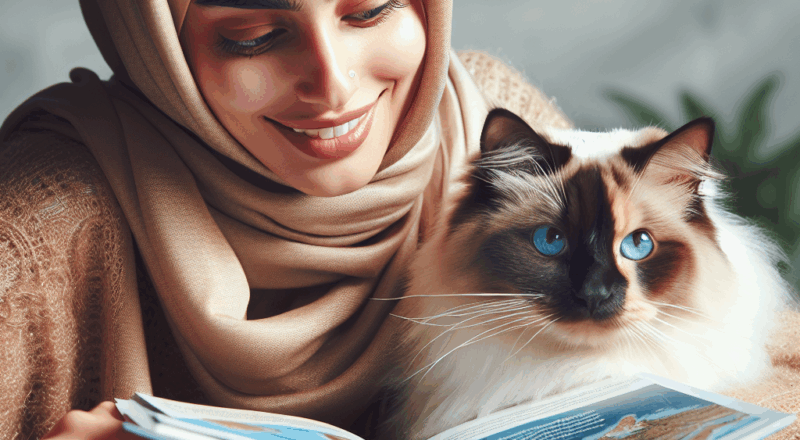The Irresistible Charm of the Ragdoll Cat
The Ragdoll cat is renowned for its striking blue eyes, silky coat, and laid-back demeanor, making it a popular choice among cat enthusiasts. This breed, characterized by its large size and affectionate nature, has a captivating history and an engaging personality that endears itself to families worldwide.
Key Characteristics of the Ragdoll Cat
| Characteristic | Description |
|---|---|
| Size | Large and muscular |
| Coat | Long, silky fur |
| Temperament | Affectionate, gentle, and relaxed |
| Life Span | 12 to 17 years |
| Exercise | Moderate level needed |
Strengths and Weaknesses
Strengths: Ragdoll cats are famously gentle and enjoy human companionship, making them excellent lap cats. Their docile nature makes them ideal for households with children, as they are tolerant and rarely become aggressive.
Weaknesses: While their calm demeanor is generally a strength, it may be challenging if you’re seeking a highly energetic pet. Additionally, their long coats require regular grooming to prevent matting.
Health and Well-being
It’s important to be proactive about the health of your Ragdoll. Regular veterinary check-ups and vaccinations are essential. Common health issues include heart conditions and urinary tract problems. Ensuring a balanced diet and maintaining a regular grooming routine are critical components of Ragdoll care.
Ragdoll Behavior and Social Interaction
Ragdolls are known for their social nature, often following their owners from room to room. They typically get along well with other pets and adjust comfortably to crowds, though they appreciate quiet and stable environments. While they enjoy playtime, their activity level is moderate, and they often prefer cuddling to boisterous games.
Interaction with Children and Adults
The gentle and patient nature of Ragdolls makes them perfect for homes with children. They are less likely to be startled by loud noises, and their tolerance means they can endure the occasional overenthusiastic hug. Adults will find their calm and relaxed personality welcoming at the end of a busy day.
Proper Care: Nutrition and Training
Keeping your Ragdoll in peak condition involves a nutritious diet and regular meals. Consider investing in high-quality cat food tailored for their needs. Training is typically unnecessary due to their natural sociability, but positive reinforcement can reinforce good behaviors.
The Joy of Adoption
Adopting a Ragdoll can be rewarding. Many cats require homes, and adopting gives them a second chance, providing you with a grateful pet that forms strong bonds. Explore local shelters and pet adoption agencies to find your perfect companion.
Managing Pet Expenses
Owning a pet involves costs beyond initial adoption fees, including food, grooming, vet visits, and toys. Budgeting for these expenses ensures your Ragdoll receives the best care.
Animal Laws and Rights
Familiarize yourself with pet ownership laws and animal rights in your area. Responsible pet ownership includes understanding legal obligations and ensuring your pet’s welfare complies with local regulations.
Saiba mais
To further ensure your Ragdoll’s happiness and health, download our exclusive guide:
Discover the Secrets to a Healthy and Balanced Diet for Your Dog with Over 40 Delicious and Nutritious Recipes
Click the image below to learn more:
Here are 20 more important things you need to know through this comprehensive guide:
- Understand common signs of illness in Ragdolls.
- Learn how diet impacts weight control.
- Discover grooming techniques for healthy coats.
- Identify stressors that affect feline well-being.
- Learn tricks for administering medication.
- Explore popular toys for mental stimulation.
- Consider insurance options for veterinary care.
- Build a safe home environment for pets.
- Ensure clean litter habits and hygiene.
- Recognize when a pet needs emergency care.
- Participate in local Ragdoll community groups.
- Set up playdates with other cats for socializing.
- Develop a daily routine that’s suitable for your pet.
- Plan pet-friendly travel and vacations.
- Debunk myths about Ragdoll temperament.
- Evaluate the benefits of microchipping your pet.
- Consider adopting from breed-specific rescues.
- Understand the importance of spaying/neutering.
- Explore ways to enrich indoor environments.
- Stay informed on the latest Ragdoll research.
Ragdoll cats are a breed known for their gentle temperament, striking appearance, and affectionate nature. In this comprehensive guide, we delve into the intriguing world of Ragdolls, exploring their history, characteristics, and essential care requirements for new pet owners.
History of the Ragdoll Cat
The Ragdoll cat was developed in the 1960s by Ann Baker in California. She aimed to create a new breed with a unique personality that was friendly and docile. The result was a stunning cat that loved to be held and would go limp when picked up, hence the name ‘Ragdoll’. Over the years, this breed has gained immense popularity worldwide.
Famous Ragdoll Owners
One of the most notable celebrities associated with Ragdolls is American singer and actress Katy Perry. She has a beautiful Ragdoll named ‘Mighty’ that often features in her social media posts. Mighty is known for his playful antics and affectionate demeanor, reflecting the breed’s loving nature.
Characteristics of Ragdoll Cats
Ragdolls are large, striking cats with a semi-long fluffy coat, blue eyes, and a gentle disposition. Below is a table detailing their key characteristics:
| Characteristic | Description |
|---|---|
| Size | Large (12-20 lbs) |
| Coat | Semi-long, soft and silky |
| Color Patterns | Colorpoint, mitted, bicolor |
| Temperament | Affectionate, social, docile |
| Life Expectancy | 12-15 years |
Global Popularity
Ragdolls are popular in many countries. Here’s a table showcasing the countries where this breed stands out:
| Country | Popularity Ranking |
|---|---|
| United States | 1 |
| Canada | 2 |
| UK | 3 |
| Australia | 4 |
| Germany | 5 |
Choosing the Right Pet
When considering whether to adopt a Ragdoll or any cat, assess your living situation. Ragdolls thrive in homes where they receive attention and affection. If you have a quiet environment and can spend time with your pet, a Ragdoll would be an excellent choice.
The Importance of Adoption
Choosing to adopt a Ragdoll pendant over buying from breeders is crucial. Adoption gives a home to an animal in need, and many rescues have purebred Ragdolls looking for loving homes. Understand the necessary steps and process involved in adopting.
First Steps when Bringing Home a New Ragdoll
When your Ragdoll arrives home, it’s essential to create a welcoming environment. Ensure it has a cozy bed, food and water bowls, litter box, and some toys to keep it entertained.
Nutrition for Ragdoll Cats
Ragdolls need a balanced diet. Make sure you provide high-quality cat food formulated for their age and size. Always follow feeding guidelines regarding portion sizes and schedule feeding times.
Hydration
Fresh water should be available at all times. Hydration is vital for the overall health of your Ragdoll.
Vaccination and Deworming
Keep up with the necessary vaccinations and regular deworming schedules for your Ragdoll. Consult a vet for the best vaccination calendar.
Regular Vet Check-ups
Schedule regular vet visits to monitor your Ragdoll’s health, ensuring early detection of potential health problems.
Grooming and Hygiene
Regular grooming is essential for Ragdolls. Brush their fur several times a week, trim their nails, and keep their ears and dental health in check.
Physical Exercise
Encourage physical activity through play. Ragdolls enjoy interactive toys and exploring their environment.
Playtime and Environmental Enrichment
Engage your Ragdoll with stimulating toys and games to keep their minds active.
Socialization
Expose your Ragdoll to different people and environments early to enhance their social skills.
Basic Training
Teach essential commands such as ‘come’ and ‘sit’ to ensure safety and promote good behavior.
Handling Unwanted Behaviors
Identify and address problems like aggression or separation anxiety through positive reinforcement and patience.
Identification
Ensure your Ragdoll has a collar with identification and consider microchipping for added security.
Home and Outdoor Safety
Prevent accidents at home and supervise your Ragdoll during outdoor excursions.
Legal Aspects and Regulations
Be aware of local laws regarding pet ownership and care. Ensure responsible ownership.
Financial Responsibilities
Prepare a budget for food, vet visits, grooming, and other expenses as a pet owner.
Emotional Impact
Pets bring immense joy and emotional support to their owners, significantly improving mental well-being.
Caring for Aging Ragdolls
Special care may be needed as Ragdolls age. Regular veterinary check-ups are essential.
Dealing with Loss
Unfortunately, pets may not live as long as we would like. Seek support from friends and professionals when grieving the loss of your beloved companion.
Transform your Dog’s Behavior in Just Days!
To enhance your experience with your Ragdoll or any pet, consider tools that help with training and behavior management.



/hotmart/checkout_custom/10424f92-b07f-4561-bff4-bf470c0e4846/6t29rz3e.jpg)